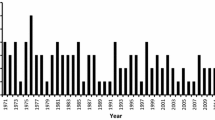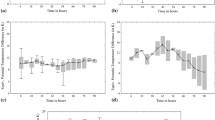Abstract
An attempt is made in this study to develop a model to forecast the cyclonic depressions leading to cyclonic storms over North Indian Ocean (NIO) with 3 days lead time. A multilayer perceptron (MLP) model is developed for the purpose and the forecast quality of the model is compared with other neural network and multiple linear regression models to assess the forecast skill and performances of the MLP model. The input matrix of the model is prepared with the data of cloud coverage, cloud top temperature, cloud top pressure, cloud optical depth, cloud water path collected from remotely sensed moderate resolution imaging spectro-radiometer (MODIS), and sea surface temperature. The input data are collected 3 days before the cyclogenesis over NIO. The target output is the central pressure, pressure drop, wind speed, and sea surface temperature associated with cyclogenesis over NIO. The models are trained with the data and records from 1998 to 2008. The result of the study reveals that the forecast error with MLP model varies between 0 and 7.2 % for target outputs. The errors with MLP are less than radial basis function network, generalized regression neural network, linear neural network where the errors vary between 0 and 8.4 %, 0.3 and 24.8 %, and 0.3 and 32.4 %, respectively. The forecast with conventional statistical multiple linear regression model, on the other hand, generates error values between 15.9 and 32.4 %. The performances of the models are validated for the cyclonic storms of 2009, 2010, and 2011. The forecast errors with MLP model during validation are also observed to be minimum.














Similar content being viewed by others
References
Bhalme HN (1972) Trends and quasi-biennial oscillation in the series of cyclonic disturbances over the Indian region. Indian J Meteorol Geophys 23(3):355–358
Bodri L, Cermak V (2000) Prediction of extreme precipitation using a neural network: application to summer flood occurrence in Moravia. Adv Eng Softw 31:311–321
Bose NK, Liang P (1995) Neural Network Fundamentals with Graphs, algorithms and applications, McGraw Hill, I edn. The MIT Press, Bambridge
Chaudhuri S (2006) A hybrid model to estimate the depth of potential convective instability during severe thunderstorms. Soft Comput Fusion Found Methodol Appl 10:243–248
Chaudhuri S (2010) Convective energies in forecasting severe thunderstorms with one hidden layer neural net and variable learning rate back propagation algorithm. Asia Pacific J Atmos Sci 46(2):173–183
Chaudhuri S, De Sarkar A (2009) Severity of tropical cyclones atypical during E1 Nino: a statistical elucidation. Asian J Water Environ Pollut 6(4):79–85
Chaudhuri S, Middey A (2011) Adaptive neuro-fuzzy inference system to forecast peak gust speed during thunderstorms. Met Atmos Phys 114:139–149
Chaudhuri S, Middey A, Goswami S, Banerjee S (2012) Appraisal of the prevalence of severe tropical storms over Indian Ocean by screening the features of tropical depressions. Nat Hazards 61(2):745–756
Chaudhuri S, Dutta D, Goswami S, Middey A (2013) Intensity forecast of tropical cyclones over North Indian Ocean using multi layer perceptron model: skill and performance verification. Nat Hazards 65:97–113
Dvorak VF (1975) Tropical cyclone intensity analysis and forecasting from satellite imagery. Mon Weather Rev 103(5):420–430
Elsberry RL, Lambert TDB, Boothe MA (2007) Accuracy of Atlantic and eastern north Pacific tropical cyclone intensity forecast guidance. Weather Forecast 22:747–762
Gardner MW, Dorling SR (1998) Artificial neural networks (the multilayer perceptron)—a review of applications in the atmospheric sciences. Atmos Environ 32:2627–2636
Haykin S (1999) Neural networks, a comprehensive foundation, 2nd edn. Prentice Hall, New Jersey
Houze RA, Smull BF, Lee WC, Bell MM (2007) Hurricane intensity and eyewall replacement. Science 315:1235–1238
Hsieh WW, Tang B (1998) Applying neural network models to prediction and data analysis in meteorology and oceanography. Bull Am Meteor Soc 79:1855–1870
India Meteorological Department (2002) Damage Potential of Tropical Cyclones, Published by the office of Additional Director General of Meteorology (Research), IMD Tech Note 71
Kidder SQ, Gary WM, Vonder TH (1978) Estimating tropical cyclone central pressure and outer winds from satellite microwave data. Mon Weather Rev 106(10):1458–1464
Luo Z, Stephens GL, Emanuel KA, Vane DG, Tourville ND, Haynes JM (2008) On the use of cloud sat and MODIS data for estimating hurricane intensity. IEEE Geo Sci Remote Sens Lett 5(1):13–16
Maqsood I, Muhammad RK, Abraham A (2004) Neurocomputing Based Canadian Weather Analysis, Computational Intelligence and Applications. Dynamic Publishers Inc., USA, pp 39–44
Pal SK, Mitra S (1999) Neuro-fuzzy pattern recognition: Methods in soft computing. Wiley, New York
Perez P, Reyes J (2001) Prediction of particulate air pollution using neural techniques. Neural Comput Appl 10:165–171
Rao KN, Jayaraman S (1958) A statistical study of frequency of depressions/cyclone in the Bay of Bengal. Indian J Meteorol Geophys 9:233–250
Velden CS (2006) The Dvorak tropical cyclone intensity estimation technique: a satellite-based method that has endured for over 30 years. Bull Am Meteorol Soc 87(9):1195–1210
Wedge et al (2005) On neural network architectures and overtopping. Proc Inst Civil Eng Maritime Eng 14015:1–11
WMO technical document No. 84 (2010) Tropical cyclone programme, TCP-21, Tropical Cyclone operational plan for the Bay of Bengal and the Arabian Sea
Wong V, Emanuel KA (2007) Use of cloud radars and radiometers for tropical cyclone intensity estimation. Geophys Res Lett 34(12). doi:10.1029/2007GL029960
Acknowledgments
The authors thank IMD, GOI and NOAA for making the data available for research. The authors thank the anonymous reviewers for constructive comments and suggestions.
Author information
Authors and Affiliations
Corresponding author
Appendix: Statistical skill score parameters (Chaudhuri and Middey 2011; Chaudhuri et al. 2012)
Appendix: Statistical skill score parameters (Chaudhuri and Middey 2011; Chaudhuri et al. 2012)
Probability of detection (POD), \( {\text{POD}} = \frac{a}{(a + c)} \)
Critical success index (CSI), \( {\text{CSI}} = \frac{a}{(a + b + c)} \)
Hit rate (HR), \( {\text{HR}} = \frac{(a + d)}{n} \)
False alarm ratio (FAR), \( {\text{FAR}} = \frac{b}{(a + b)} \)
Yule’s Q, \( {\text{Yule's}}\,Q = \frac{(ad - bc)}{(ad + bc)} \)
True skill statistic (TSS), \( {\text{TSS}} = \frac{(ad - bc)}{(a + c)(b + d)} \) Heidke skill score (HSS), \( {\text{HSS}} = \frac{2(ad - bc)}{{\left[ {(a + c)(c + d) + (a + b)(b + d)} \right]}} \) where “a” is the number of times that forecast “Yes” matched with observed “Yes”, “b” is the number of times that forecast “Yes” did not match with observation, “c” is the number of times that forecast is “No” but observation is “Yes,” and “d” is the number of times that forecast “No” matched with the observation “No”(Table 6).
Rights and permissions
About this article
Cite this article
Chaudhuri, S., Goswami, S. & Middey, A. Medium-range forecast of cyclogenesis over North Indian Ocean with multilayer perceptron model using satellite data. Nat Hazards 70, 173–193 (2014). https://doi.org/10.1007/s11069-013-0805-9
Received:
Accepted:
Published:
Issue Date:
DOI: https://doi.org/10.1007/s11069-013-0805-9




